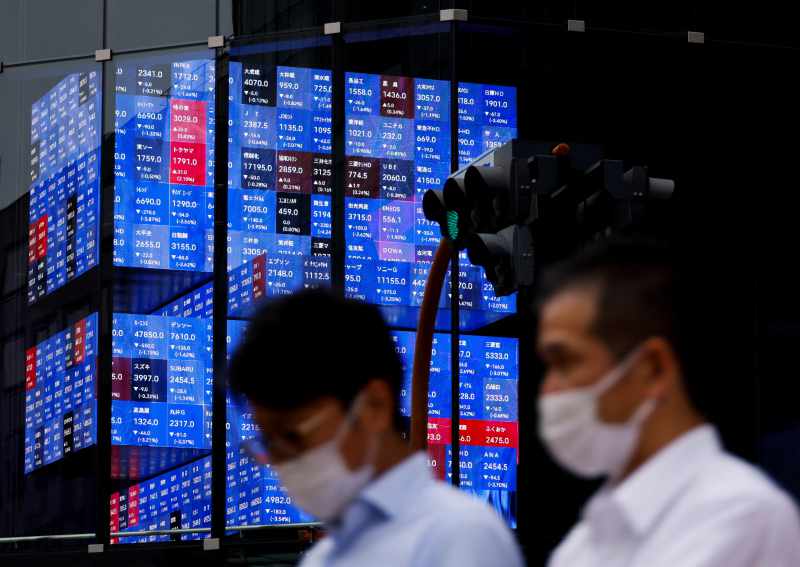Asian shares muted ahead of U.S. payrolls report

People pass by an electronic screen showing Japan’s Nikkei share price index inside a conference hall in Tokyo, Japan June 14, 2022
16:17 JST, September 2, 2022
SYDNEY, Sept 2 (Reuters) – Asian shares struggled for direction on Friday and the dollar stood tall ahead of a key U.S. jobs report as investors braced for more aggressive rate hikes from the Federal Reserve, while fresh lockdowns in China fueled concerns about global growth.
However, things look brighter in European markets, with the pan-region Euro Stoxx 50 futures STXEc1 last up 1.2%, German DAX futures FDXc1 rising 1.3% and FTSE futures FFIc1 0.75% higher.
All eyes are now set on U.S. August nonfarm payroll data due on Friday.
Analysts expect 300,000 jobs were added last month, while unemployment hovered at 3.5%. Investors may not like a strong number if it supports a continuation of aggressive rate hikes from the Fed, which could further boost the U.S. dollar and spur a sell-off in bonds.
Futures markets 0#FF: have priced in as much as a 75% chance the Fed will hike by 75 basis points at its September policy meeting, compared with a 69% probability a day earlier.
On Friday, MSCI’s broadest index of Asia-Pacific shares outside Japan .MIAPJ0000PUS fell 0.5%, heading for its worst weekly performance since mid-June with a tumble of 3.6%, as rising expectations of hawkish global rate hikes hit risky assets.
Japan’s Nikkei .N225 dipped 0.1%, Chinese bluechips .CSI300 dropped 0.5%, Hong Kong’s Hang Seng index .HSI fell 1.0% and South Korea .KS11 remained largely unchanged.
“Markets broadly continue to absorb that central banks’ ‘whatever it takes’ to lower inflation message means much slower global economic growth,” said Tobin Gorey, agriculture strategy director at the Commonwealth Bank in a note. “And China’s weakening economy is an amplifying special factor in that scenario.”
On Thursday, the southwestern Chinese metropolis of Chengdu announced a lockdown of its 21.2 million residents, while the technology hub of Shenzhen also rolled out new social distancing rules as more Chinese cities tried to battle recurring COVID-19 outbreaks. Read full storyRead full story
Analysts at Nomura said what is becoming more concerning is that COVID-19 hotspots in China are shifting away from remote regions and cities to provinces that matter much more to China’s national economy.
“We maintain the view that China will keep its zero-COVID policy until March 2023, when the (leadership) reshuffle is fully completed, but we now expect a slower pace of easing of the zero-COVID policy after March 2023,” Nomura said.
Oil prices tumbled 3% overnight before recovering some ground on Friday but were on track to post sharp weekly losses on fears COVID-19 curbs in China and weak global growth will hit demand.
Brent crude LCOc1 futures rose 2% to $94.15 a barrel on Friday while U.S. West Texas Intermediate (WTI) crude CLc1 futures were up by a similar margin to $88.34 a barrel.
In the currency markets, the dollar index =USD, which measures the greenback against a basket of six currencies, hovered near its 20-year high at 109.49 on Friday. It also hit a new 24-year high against the rate-sensitive Japanese yen and stood back above 140 yen per dollar.
Overnight, U.S. stocks eked out modest gains with the U.S. S&P 500 index .SPX climbing 0.3%. The Nasdaq Composite .IXIC finished down 0.3%.
In Europe, fears of a recession are on the rise, with a survey showing on Thursday that manufacturing activity across the euro zone declined again last month as consumers feeling the pinch from a deepening cost of living crisis cut spending.



